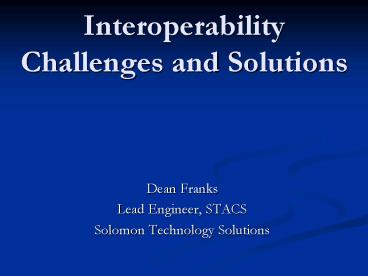Interoperability Challenges and Solutions PowerPoint PPT Presentation
1 / 23
Title: Interoperability Challenges and Solutions
1
InteroperabilityChallenges and Solutions
- Dean Franks
- Lead Engineer, STACS
- Solomon Technology Solutions
2
InteroperabilityChallenges and Solutions
- Trends in Interoperability Demand
- Core Interoperability
- Infrastructure Interoperability
- Command / Tactical Comms Vehicles
- Edge Interoperability
- VOIP / SIP
- Technology
- Public Safety Applications
- STACS
3
Trends inInteroperability Needs
- Increased incidence of wildfires due to drought
- Budget restrictions force increased dependence on
mutual response - Need for readiness to respond to multi-site and
large scale events (civil unrest, infrastructure
failure, internal and external terrorism) - Public Expectations
4
Centralized (Infrastructure) Interoperability
- Pervasive network of trunked radio repeaters
interconnected via microwave or lease lines - Pros
- Same procedures as normal day-to-day radio
operations, minimal training - Cons
- Infrastructure dependent
- Usually does not degrade gracefully as
infrastructure fails - Often provides minimal interop with outside
agencies equipment
5
Command / TacticalComms Vehicles
- Vehicle mounted radio interop switch with
multiple radios, independent power and often
satellite uplink - Pros
- Provides comfortable working environment for IC
staff - Cons
- Complex, fragile technology
- High level of training required for comms
operator - Often does not provide usable phone service
- Satellite systems are usually slow
- Expensive, depends on road infrastructure
6
General Interop Problems
- Vendor Lock-in
- Infrastructure Cost
- Project Risk and Lead Time
- Shifting Standards
- Lack of Real Interoperability
7
Introduction to VOIP / ROIP
- Analog voice signals are converted to digital
form and transmitted over IP networks. - Many signalling standards exist
- SIP (IETF)
- H.323 (ITU)
- MGCP / SCCP (IETF/Cisco)
- IAX (Asterisk)
- Many compression standards exist
- uLAW/aLAW (G.711)
- G.729/a/b
- GSM
- iLBC, LPC10, G.723, etc etc etc
8
VOIP Terms
- SIP primary network protocol used to handle
VOIP calls on IP networks - CODEC COmpressor/DECompressor program or
hardware to manage compression of digital audio - FXS a device that provides dialtone
- FXO a device that consumes dialtone
- ATA Analog Terminal Adapter convert digital
VOIP signal on ethernet to FXS analog port
9
VOIP SIP / RTP
- SIP Session Initiation Protocol
- TCP or UDP based
- Allows a device to register with a server
- Allows a device to initiate a call
- Allows server to notify device of incoming call
- Signals call accept / decline / busy
- Allows for call transfer
- RTP Real-time Transport Protocol
- Transports all audio
- UDP based
- Subject to packet loss and jitter
10
VOIP Structure - Consumer
11
VOIP Structure - Corporate
12
ROIP Public Safety
13
ROIP / VOIP Convergence
14
ROIP / VOIP Convergence
- Talk from any device to any device
- Radio
- Cell phones
- Office public phones
- Dispatch console
- PC based remote dispatch
- Redundant data links
- Use inexpensive IP based networks
- Use expensive satellite networks only during
infrastructure failures or in remote locations
without infrastructure
15
VOIP / ROIP / SIP Standards
- Standardization effort in progress
- Sponsors
- NIST / OLES Office of Law Enforcement Standards
- DHS / OIC Office of Interoperability and
Compatibility - Roundtable Notes www.safecomprogram.gov/SAFECOM/
library/technology/1293_roundtableon.htm - Contact Dereck Orr dereck.orr_at_nist.gov
16
Current State of Discussions
- Solution is very likely to be SIP centric
- Multiple CODECs will be supported
- Layering VOIP on existing networks without
adequate planning and analysis can be disasterous - SIP protocol will be extended for
authentification, OOB messaging and PTT
signalling - No trace of encumbering IP yet
17
Open Source / Open Protocols
- Asterisk
- VOIP switch with support for all common protocols
and CODECs - APP-RPT
- Repeater, Simplex and Trunked radio support for
Asterisk - Support for remote bridging and remote dispatch
- Linux
- Stable platform providing for hybrid VOIP/Data
systems with QOS routing and excellent security
18
Open Source / Open Protocols
- Solomon Technology is committed to enhancing
Asterisk/App-rpt to support the DHS/NIST standard
for SIP based radio interop. - Solomon Technology implementation will be
provided free of charge with full open source. - Asterisk / App-rpt provides IAX2 based remote
radio bridging today.
19
STACS
- A small 40lb single case
- BGAN Broadband Satellite
- EV-DO/Edge cellular broadband
- Full VOIP PBX including voicemail and a real
conference bridge - 2 port radio interop bridge supporting simplex,
repeater and trunked radios, remote bridging and
remote dispatch - WiFi mesh technology
- Local WiFi for notebooks, PDAs, VOIP phones,
video and telemetry - Battery powered, 4-8 hours of operation
- IP-55 weatherproof and reliable in heavy rain
and smoke, cold and heat - Big Red Button operation, ready to use in 2
minutes
20
STACS
- Automatic Least Cost operation
- Basic Incident Management software
- Outbound voicemail
- Self-healing computer system
- Rugged and Reliable
- 100 open standards and protocols
- Works anywhere in Continental US
- Minimal training necessary, no techies needed in
field - Flexible external power, 10-18v (ovp), 110-240v
21
STACS
- 3-5 outbound phone lines
- 5-10 phones up to 15 notebooks
- Inbound/Outbound VPN capability
- 2/4Mb/s EV-DO data
- EV-DO often works even when cellular network is
congested - 220/360Kb/s BGAN data
- BGAN service is 40/month usage
- EV-DO service is 59/month unlimited
- Remote Dispatch Console available at no charge
22
INMARSAT 4 Satellite Coverage
INMARSAT BGAN service is currently available for
the continental US, South America, Africa,
Europe and Asia. The F3 satellite is scheduled
for launch 2Q2008 providing global coverage and
redundant service for the Western US (cyan oval).
23
Questions / Demo
- dfranks_at_solomontech.com
- www.solomontech.com

